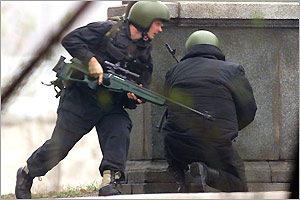If you ever wondered who handles bomb disposals when the bombs contain the bad stuff you will find this transcript of a demonstration by the Army’s TEU of interest.
|
|||||
|
A few days ago I wrote about my anger at Arabic translators being kicked out of the military. It seems I am not alone in my condemnation. I ran across some interesting remarks by Donald Rumseld about the bureaucratic explosion in Washington of the last twenty to thirty years:
Stupidity at this level is nearly criminal. The US Army dismissed six Arabic language translators on grounds which had nothing to do with their ability to serve and protect the USA. Yes, the US military does need some transformational changes. Some of its’ people need to be transformed into residents of the 21st Century – instead of the 19th. I want a military whose first concern is accomplishing their mission. One uses the resources at hand whether one likes them or not. Nothing else matters worth a damn but winning this war before millions of us die. The US DoD is studying whether to continue with its’ current broadband satellite systems or to move on to a global space laser com relay network. According to Undersecretary of the Air Force Peter Teets at a DoD News Briefing on Tuesday, Sept. 3, 2002, they hope to be ready for a decision by December 2004:
They seem primarily interested in space-space links, but I predict usefulness for space-ground links as well. Laser links have many admirable characteristics for this if you can get the pointing right. They do not have the extensive sidelobes or wide footprint of radio signals1; they are difficult to jam2; they can carry enormously more data3; and left entirely unsaid at this briefing… they are amenable to quantum cryptography4. Oh I just love the future! 1 = This makes it very difficult to intercept. Even tightly beamed microwaves have enough off axis signal to be read miles away as the Russians did in New England in the 80’s. They purchased an old country house as a diplomatic site, stuck up a bunch of antennas and started picking off White House and other phone calls. At that time the exchange number was part of a clear text header, easily filtered for out of the massive volume of long distance voice traffic. It goes without saying US ELINT sats can pick up the faint leakage of microwave links from orbit. 2 = Someone will certainly comment about the effect of fog, clouds etc. It is not as much of a problem as you think, and most especially for point to point orbital communications. Even on ground links, much depends on the frequency in use. Water vapour does not absorb at all frequencies. 3 = Think of live two way hiresolution video links between pilots in theatre and control centres elsewhere in the world; perhaps even holographic 3D heads up data displays. The possibilities are staggering. 4 = Even without encryption, quantum tricks lets them make sure undetected “man in the middle” attacks are literally impossible. Every time I see or hear the media talking about “dirty bombs” my teeth grate. Dirty bombs are nuclear weapons that are either too inefficient to “burn” most of their fissionables in the explosion or else are built intentionally to spread fallout. The media almost always means what is now being called a radiological weapon, something like a terrorist’s standard anti-personnel bomb, but packed with bits of radioactives lifted from medical equipment, old watches or what have you, instead of rusty nuts, bolts and nails. Any idiot can build one, but they will probably fail to get more than local dispersal. Bad enough in fact; but by the time the SafetyNuts are done you’d have an entire city evacuated for years over the risk of a handful of extra cancers per year. So this is more mass disruption than mass destruction unless the enemy acquire some really nasty radionucleotides and manage a good dispersal within the desired target footprint. The first type of real “dirty bomb” is what we will almost certainly get from the enemy. It is dirty because they don’t know how to make their fissionables fission before the plasma blows itself apart. When the fission process occurs there is a chain reaction in which a neutron splits one nuclei, which releases at least one more neutron and on average “a bit” that in turn cause another one or two atoms to do the same. This exponential growth happens so quickly it has no meaning on a human scale. But on the bomb level it does. Each atom releases a great deal of energy; that radiated energy turns the fissionables and the bomb casing into a plasma racing outwards at an enormous speed… which is still slow relative to the neutron cascade. If the cascade happens fast enough, virtually all of the Uranium 235 or Plutonium fissions and releases energy before the wisp of plasma blows the ghost of the bomb matter outwards. If the cascade is a bit slow the “flame” is extinquished and the cascade stopped because the remaining fissionables are too far apart to have much chance of a neutron hit. Those unfissioned materials become a nasty bit of the fallout. It is highly unlikely that an “amateur” bomb will get things right the first time, so one expects 5% or less of the material will “burn”. The other 95% gets dispersed in the mushroom cloud. This is the scenario all of us “in the know” fear: a couple kiloton fizzle with a lot of very hot debris and a deadly cloud drifting down wind. The second type of dirty bomb is even uglier. If you re-read your ’50’s literature, you’ll run across the “Cobalt Bomb”. This is a thermonuclear weapon packed with Cobalt or other materials that will generate nasty and long lived fallout. The Doomsday bombs of yore. To my knowledge, no one ever built one. It’s not a terrorist likelihood as H-Bombs are out of range of the technology of anyone but a major state at present… without help that is. A third type, which falls between the cracks of the definition, is the Neutron Bomb. This is an extraordinarily “clean” bomb with very low yield. It causes limited blast damage but it gives off an extremely intense pulse of neutrons. These kill everything (except roaches and Radiodurans bacteria) in a wide radius. The buildings are untouched and the people are dead. These were tested but not deployed1. It is doubtful anyone could build one without extensive experience or testing. Let’s pray none of us ever learn about these things first hand. 1= A clarification for those who want precision: a large number were built, but after a big political battle over deployment in the Reagan years, they were put into storage. They were perhaps disassembled during Bush Sr’s Presidency. I do not know if any of these tactical “Enhanced Radiation Weapons” remain in the US inventory. That 80 or more hostages have been killed is dreadful but the fact 750 were saved is a triumph. But there are some very stark lessons here. In 1995, a related Chechen group took over 2000 people hostage in a hospital in Budyonnovsk. After an initial attempt to free the hostages was botched with considerable loss of life by the Russian forces, a deal was cut by then Prime Minister Victor Chernomyrdin that agreed a cease-fire in the Chechen war and allowed the hostage takers to escape in return for the safety of their captives. And of course that was proof that you can indeed get the Russians to cut a deal if you are daring enough and willing to slaughter enough innocent civilians. Well I hope that Vladimir Putin has just signalled a complete rejection of that mind set. As terrible as it is that so many hostages have died, the fact is the Chechen terrorists who did this are now either dead or facing a very grim time indeed in a Russian jail… and were given nothing for their pains by the Russians. That is the only message that must be sent to terrorists everywhere, to do otherwise is to motivate such people to cause more horrors in theatres, hospitals and homes. The enemy may not fear death itself but I suspect they do indeed fear pointless death. So whatever the cost, in the long run it is cheaper in lives to never negotiate (other than as a tactical ruse). Give them the death they desire but nothing that would further their aims, no matter how small. 
Russian commando with SV-98 sniper rifle
In an article typical of London’s The Guardian newspaper – noxiously socialist but sometimes well-researched – I read a sad account of the SA80 British infantry carbine. In typical socialist fashion, James Meek takes potshots at privatization, in the context of its involvement in the debacle, speaking to the sorry state of the government-owned Royal Ordnance facility of the once-venerable Enfield:
I’d argue that the expectation of a “job for life” was part of the cause of quality problems with the weapon, but that point has been set to rest by its evident failures in societies ranging from communist Russia to corporatist Japan. What’s especially interesting is the passing mention of the involvement of Germany’s Heckler & Koch (H&K to us gunnies) in helping to fix the bloody mess:
and:
I’ve spoken to acquaintances who’ve had to carry the SA80, and a very close friend formerly of the U.S. Army Special Forces, who confirm that in very recent times, the SA80, in its A2 incarnation, has evolved into an adequate infantry carbine. It’s worth noting in some of Parliament’s own notes of 2000, H&K UK Ltd (also mentioned in MoD/DLO SA80 Individual Weapon (IW) & Light Support Weapon (LSW) Modification Programme notes) has taken over from Royal Ordnance as the Design Authority for the weapon. Mr. Meeks should admit that the only way to salvage the soiled reputation of the SA80 is complete privatization, ruthless outside testing combined with an intense feedback loop involving design & manufacturing… and years of unavoidable wait & see, with British squaddies acting as hapless test dummies. In the meantime, variants of the privately-produced (usually by Colt and Bushmaster) U.S. M-16 (e.g. the M4A1) will continue as the choice of the SAS, not surprising given the “2nd culture” nature of most special forces units worldwide: spec ops guys, within limits, generally get their choice of personal weapons. Russell Whitaker  There is a new generation coming up through the ranks of the US Air force, one with a steely eyed resolve much like their grandparents back in the days of WWII. The main article is here. Part III of III The long awaited third part on Iraq and war is different from what I originally intended. Strategic and military aspects remain important but the debate has moved on in a direction where evidence of Iraqi threat on its own does not convince. Strange since it provides the most obvious reason for war on Iraq – self-defence. Both the US and the UK have maintained that Iraq has breached the provisions of the UN sanctioned ceasefire agreement from the Gulf War and continues to pose a military threat to the region. Prime Minister Tony Blair’s dossier on Iraq says President Saddam Hussein has the military planning to launch a weapon of mass destruction at 45 minutes’ notice. There are other documents that deal with Iraq’s military capabilities and certainly convince me that self-defence is essential. A CSIS document Iraq’s Military Capabilities: Fighting A Wounded, But Dangerous, Poisonous Snake concludes:
Good stuff. Another one is IISS Strategic Dossier titled Iraq’s Weapons of Mass Destruction: A Net Assessment, more recent and poignant:
Hear, hear. Update: Just noticed Perry’s post below – not only he got there first with Tony’s dossier but also makes a similar point. Oh, well, great minds think alike. Insights come in varied and peculiar forms, such as those decanted from the lips of such British sages as Rab C. Nesbit to the north and the Macc Lads from a tad further south. To be honest I think the Macc Lads are at least as reliable as DEBKA when it comes to military analysis and probably rather better… well certainly more forthright. Read the article and make up your own mind.
Before you read the linked Spectator article, let me proffer some linguistic assistance to our non-British readers… ‘Boddingtons’ is an inexpensive but far from ineffective beer in considerable favour with the broader end of Britain’s socioeconomic pyramid. One of the responses to Part II of Libertarians and war, namely the comment by Billy Beck, has puzzled me sufficiently to turn what would otherwise be a rather lengthy comment into another blog. (Part III on Strategic considerations is yet to come…)
It took me a while to work out how anyone could think that the logic of my argument extents to blurring the distinction between combatants and civilians. I came to the conclusion that it must be due to misunderstanding of two other concepts – “monopoly on the use of force” and “collective responsibility” – that I want to clarify. It is precisely because the state has the monopoly on the use of force that a civilian population can never be a legitimate target. The monopoly on force means that the state usurps the use of force and prevents individuals from using it against external enemies (foreign armies and terrorists) and in many cases, e.g. such as in the UK, internal enemies (criminals). For my part, I resent the state’s exclusive use of force, especially regarding the latter category.
The quote above (from Memoirs of Gen. Curtis LeMay) does distinguish between military and civilian installations and makes it explicit that “the veneer was pretty thin in Japan”. It also admits that civilian casualties occurred but the point is specifically made that they were aiming at military targets, never at civilians. Although civilian casualties were to be expected given the [Japanese] system of dispersal of industry… It is for circumstances like these the double effect doctrine has something to say. The bad effect may be known beforehand but provided it is not the intention and the act itself is required for bringing about the needed good effect, the doctrine of double effect allows waging a war despite foreseeble civilian casualties. I do not see how it opens up a possibility that civilians may ever be a legitimate target just because they have their role in the functioning of the military machine. It is self-evident and blindingly obvious that an army cannot be raised, funded and function without civilian economy and infrastructure supporting it but I fail to see how it can provide a justification for turning civilians into a military target! It is Al-Qaeda, as Billy Beck correctly points out, and not me, that cannot make the distinction between the effect civilians may have on the efficacy of the military and the moral grounds for turning them into a target for their ‘war’. As I argue in my posting on just war, it is equivalent to taking defenceless hostages – civilians disarmed by the state are targeted by the enemies of that state for its actions. Here the notion of collective responsibility becomes relevant as it is often implicit in statements of those who hold an individual responsible for actions carried out by a collective entity, such as state merely on the basis of that individual’s membership of such entity. Would you say that all German civilians were equally and personally responsible for the Holocaust and WWII, by virtue of being citizens of the German state or even by virtue of working in one of the armaments factories trying to make a living?! Surely, there is a distinction to be made and one does not need a rigorous moral code to see that. The doctrines of just war and double effect mean to provide guidance in situations where our moral instincts are torn between two ‘unacceptable’ options. They are meant to provide a moral template, not definitive or comforting answers, for those who want to know right from wrong even in the most difficult situations. They still leave plenty of room for formulation of policy and strategy… |
|||||

All content on this website (including text, photographs, audio files, and any other original works), unless otherwise noted, is licensed under a Creative Commons License. |
|||||



